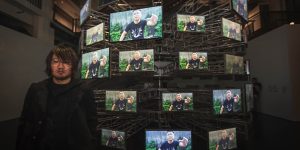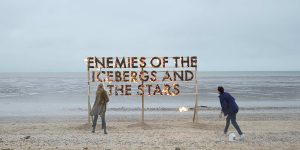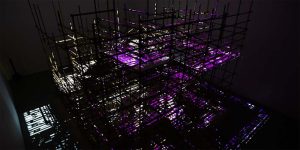Gallery Spaces

Rêverie Reset
Yan Lei (CN)
Rêverie Reset is a system that expands on Yan Lei’s practice of dissolving images into concepts. A large-scale installation makes use of cutting-edge computational systems and networking technologies in order to reaffirm the artist’s notion of the artificiality of representation and the irrelevance of the image.

The Hudson
Maria Marshall (CH/UK)
Men in suits and ties carrying briefcases appear on the Hudson River and walk onto the beach and beyond the frame. Their clothes are wet. The same men appear with dry clothes and walk out of frame. The soundtrack is of a Trump speech about putting up the wall, sped-up to sound like Mickey Mouse. The soundtrack: Three of the same soundtracks are played at different intervals so that there will be a cacophony of sound, but audible wherever the viewer stands.

Estuary Poem for Wyndham Lewis
Robert Montgomery (UK)
A memorial fire poem to Wyndham Lewis at the point where the River Thames, after leaving London, meets the North Sea. This work is both a ceremonial elegy to Lewis (an important figure in British Modernism and the editor of the concrete poetry journal BLAST) and an updating of his phrase “Enemies of the Stars” for the age of ecological crisis. It seems we have all in the age of ecological crisis become enemies of the icebergs and the stars…

bitTOWER
Wu Juehui (CN)
bitTOWER is inspired by the uroboros and each element of the installation acts as a visual metaphor. The scaffold matrix creates a space with a limited mass, as though the epidermis of the excessively expanding city has been torn apart and exposed its internal organs. The cycle of lights act as moon and sun, with shadows of mottled steel pipes expanding the borders of the matrix. The interplay of the lights and projected digital images create a virtual world shifting swiftly between night and day. The spiral cases inside the matrix overlap, and just like the uroboros, beginning where it also ends. The immersive environment opens a wormhole to another dimension for the audience, with the synesthetic ceremony leading to a sense of reverie.

Device Art Chronicle
Machiko Kusahara (JP)
The term “device art” is already part of the vocabulary of contemporary art. The Device Art Chronicle demonstrates how the concept was developed within the Device Art Project, aiming to explain the prehistory of media art, and how local and global features are connected. We were able to define features that characterize Japanese media art (e.g. playfulness), which can be better understood by relating them to earlier cultural traditions. Nevertheless, the essence of device art is also international and its features are shared by many works of media art.

post-window
TopLap – Lina Bautista (CO/ES), Ivan Paz (MX/ES)
post-window reflects on the semantic, semiotic and affective bridges connecting our imaginary sonic and written languages. It is conceived as a high-level device for sound live coding that visualizes algorithmic sentiment analysis. It is a window that invites us to find the nonconformity within the limits of the algorithm. The training bias, the implicit values of humans involved in data collection and processing, might never replicate the plasticity of the individual mind.

Mezza: Archivo Liberado
Gonzalo Mezza (CL), Sebastián Vidal Valenzuela (CL)
Mezza: Archivo Liberado reviews, in the eyes of a media art pioneer, the initial processes of technological implementation in Chilean art. By a selection of documents and works, the exhibition offers a revisionist view, presented as an exercise in media archeology, exploring one’s own history (of middle age) under different layers through a body of work that progressively models and anticipates important conflicts of today’s society.

Archivo Liberado / Released Archive
Gonzalo Mezza (CL)
Archivo Liberado is a curatorial project that reviews the archives and works (1969-1990) by the Chilean artist, pioneer of media art, Gonzalo Mezza (1949-). For sixty years, his innovative work has been focused on the implementation of media technologies in Chile.

Remake the Media History!
Martina Ivičič (SK)
Born online, new media art is like a cultural nomad aimlessly walking through the rhizomatic meanders of an archive without walls. It flickers back and forth in the annals of history and crosses geographic, cultural, and institutional boundaries, both physically and virtually. The aim of the subject The Best of New Media Art is to acquaint students with media art history in a similar way.

Paintball Techniques
Patricio Rivera (AR)
The piece addresses the declarative character of the shot as a force of performative enunciation and exclamation point of an intention; a statement, although regulated by law, free to be executed within the elusive alibi of an artwork.


